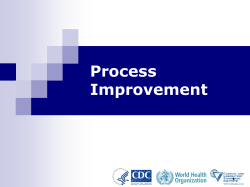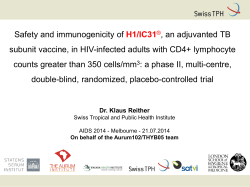
The last frontier in Global Health Partnerships: still to be conquered.
The last frontier in Global Health Partnerships: still to be conquered. Rachel Thibeault Occupational Therapy Program Faculty of Health Sciences University of Ottawa Before naming the frontier, a brief history of Global Health. In the 60s, 70s, and 80s, Global Health partnerships were nearly non-existent. We responded to trade imperatives. Massey-Ferguson tractors in the Sahara Soviet snowplows in Bamako. We lost face, so we moved on. In the late 80s, still no true partnership: top down approaches dictated to the Global South by the North. We often targeted the wrong populations. And tackled the wrong issues. Cerebral palsy as a CIDA priority in Burkina Faso. We moved along. In the 90s, we got some of the right populations. But still went at it the wrong way. AIDS and the World Bank and IMF. We got to a critical junction. In the 2000s, we started asking radical questions: Should we consult the target populations as to their needs and wants? They are in no way experts, but could they have something to bring to the table? The timid rise of Participatory Action Research (PAR) in Global Health. Participatory Action Research PAR practitioners make a concerted effort to integrate three basic aspects of their work: participation (life in society and democracy), action (engagement with experience and history), and research (soundness in thought and the growth of knowledge) (Chevalier and Buckles, 2013). SAS2 (Social Analysis Systems-2) Tools for community consultation, mobilization, program planning and monitoring that allow the handling of complex situations, promote social change, empowerment and sustainability. Gradually, often reluctantly, target populations are given a voice in the needs assessment. Why is it important? So the interventions fit and stick. We have made significant gains that must be celebrated. But we also need to go further. He who controls the data collection controls the community’s future. The last frontier in a true Global Health partnership is the sharing of power in the Monitoring, Evaluation and Learning (MEL) process, currently the exclusive domain of the funder or researcher. What would a true partnership look like? Empowering ( Empowerment Evaluation by Fetterman & Wandersman, 2005) Capacity building & organizational learning Community ownership & democratic participation Community knowledge & locally designed evidence-based strategies What would a true partnership look like? Transformative - transformative evaluation (Mertens, 2009) Inclusion and diversity Mixed methods What would a true partnership look like? Utilization-focused evaluation (Patton, 2012) Involving primary intended users – the community monitors its own progress. Fostering use of evaluation process and findings. Theory-driven evaluations (Chen, 2005) Making the implicit explicit Situating the evaluation within a comprehensive logic model. Looks complicated? Not rocket science. Annex 2 – Gradual Growth Evaluation Matrix - Example drawn from the Pre-School pilot study Gradual Growth Evaluation Matrix (Thibeault & MacDonald, 2012) Engagement Indicators Process Indicators Outcome Indicators Result Indicators Children rush to the bus in the morning - qualitative know sufficiently well what homework they have to do - level of comfort - scale have fun, engage more (attention span - duration) encourage other children to join (number) Parents spend time with homework respectful p-t. communicationperception observable new learning e.g. counting children teach siblings/parents (number) Educators come to work earlier exact knowledge of expectations – level of comfort - scale children get better marks in their class better morale for educators (scale) Managers provide more staff support timely, accurate reports from staff children make Grade R (number) more parents wanting POP for their children (number) Funders X-year commitment regular progress reports from agency highlighting rates of children’s progress - outcome indicators number of children who complete primary education number of children taking part in provincial/national events (sports competitions…) Who’s resisting the trend? WHO Governments Academic researchers narrow interpretation by Ethics Review Boards of the Tri-Council Policy Statement on Ethical Conduct for Research Involving Humans In the end, using these tools or others is not what matters. ‘Nothing about us without us.’ References CDC. (1999). Framework for program evaluation in public health. MMWR, 48(11), 1-35. Chen, H.T. (2005). Practical program evaluation: Assessing and improving planning, implementation, and effectiveness. Thousand Oaks: SAGE Publications. Fetterman, D.M., & Wandersman, A. (2005). Empowerment evaluation principles in practice. Eds. New York: Guilford Press. Grandisson, M., Hébert, M., Thibeault, R. (2012, Submitted). A systematic review on how to conduct evaluations in communitybased rehabilitation. Green, L.W. & Kreuter, M.W. (2005). Health Program Planning: An Educational and Ecological Approach. 4th edition. NY: McGrawHill Higher Education. ILO, UNESCO, & WHO. (2004). CBR Matrix. Retrieved 2011/02/11 from: http://www.who.int/disabilities/cbr/cbr_matrix_11.10.pdf Mertens, D.M. (2009).Transformative research and evaluation (1st ed.). New York: Guilford Press. Patton, M.Q. (2012) Essentials of utilization-focused evaluation. Thousand Oaks: SAGE Publications. Rossi, P.H., Lipsey, M.W., & Freeman, H.E. (2004). Evaluation: A systematic approach (7th ed.). Thousand Oaks: SAGE Publications. WHO, ILO, UNESCO, IDDC (2010). Community-based rehabilitation (CBR) Guidelines. WHO Press, Geneva. Retrieved September 25th, 2012 from URL: http://www.who.int/disabilities/cbr/guidelines/en/index.html
© Copyright 2025





















